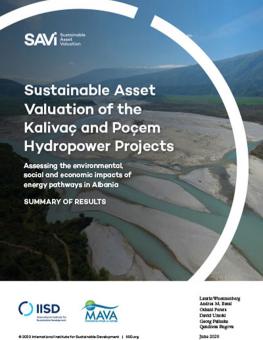
Sustainable Asset Valuation of the Kalivaç and Poçem Hydropower Projects
The SAVi results suggest that the hydropower assets cannot be considered a preferable solution to generate electricity for the Albanian people as they cause higher costs to communities, the environment and the state than they generate benefits.
Key Messages
- The SAVi assessment informs the public debate in Albania on the environmental and societal costs of the hydropower projects Poçem and Kalivaç, and sheds light on the economic concerns regarding hydropower performance.
- The SAVi results suggest that the two hydro assets cannot be considered a preferable solution to generate electricity for the Albanian people, as their lifetime costs, societal burdens, and tax losses are greater than their generated benefits. Solar photovoltaic represents a more beneficial and viable alternative for generating a comparable amount of electricity in Albania.
The Sustainable Asset Valuation (SAVi) was applied to the hydropower projects Poçem and Kalivaç to calculate the costs of environmental, social and economic externalities caused by these two projects currently being developed on the Vjosa River. The assessment also sought to calculate how these projects perform if climate change risks materialize. The assessment results presented in this report inform the public debate on the environmental and societal costs of hydropower and shed light on economic concerns of hydropower performance. Results are compared to the performance of a hypothetical solar PV system and a hypothetical onshore wind farm.
Read the digital story Why Albania Should Shift Away From Hydropower and Preserve the Last Free-Flowing River in Europe
The SAVi results demonstrate that the two hydro assets imply considerable trade-offs. These emerge because of adverse effects on communities, economic sectors (such as agriculture and tourism), and ecosystems along the Vjosa River. Results of the cost-benefit analysis amount to negative EUR 233 million and negative EUR 321 million for the assets Poçem and Kalivaç, respectively.
The same conclusions can be drawn from assessing the levelized cost of electricity (LCOE). Under conventional calculations, the cost per MWh of electricity would be between EUR 121 (Poçem) and almost EUR 158 (Kalivaç). When integrating the valued externalities into the LCOE, the cost per MWh of electricity would increase to EUR 184 and EUR 203, respectively. If the impacts of materialized climate change risks are taken into account, the integrated LCOEs of both hydro assets increase further.
The financial analysis results of the two hydro assets highlight that supplying electricity to the domestic market alone will not be sufficient to make the assets financially attractive because of a market environment that promises relatively low electricity offtake prices. This is indicated by a project internal rate of return (IRR) for both hydro assets of 9.32% in a conventional scenario, which is below the assumed hurdle rate of 13.5%. The project IRR drops to 3.15% if the calculated costs for sediment dredging are considered and turns negative if the monetary value of externalities is internalized.
Participating experts
You might also be interested in
Factor Gender into Transportation Planning, IISD Analyst Urges Policy-Makers
Cost-benefit decisions on new transportation infrastructure that are gender-blind create a cost for women and the societies they live in, says an analyst with the International Institute for Sustainable Development (IISD).
A Sustainable Asset Valuation of Non-Motorized Transport in Coimbatore, India
A Sustainable Asset Valuation (SAVi) of the economic, social, and environmental benefits of a non-motorized transport (NMT) network in Coimbatore, India.
New Initiative Supports Nature-Based Infrastructure for Climate Adaptation
A USD 2 million grant will fund a new venture in partnership with GEF, the MAVA Foundation, IISD, and UNIDO.
Sustainable Asset Valuation (SAVi) of Senegal’s Saloum Delta
The assessment provides an economic valuation of the contribution of the Saloum Delta to local livelihoods and regional development.